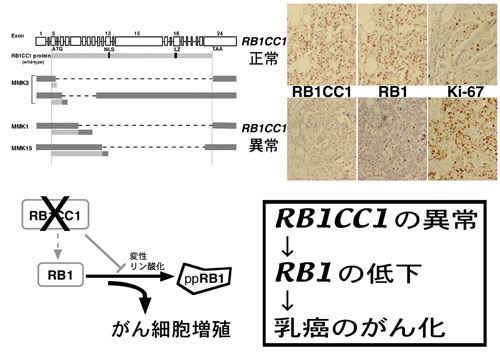| 研究論文 |
nature genetics • volume 31 • july 2002 285
Truncating mutations of RB1CC1 in human breast cancer
Tokuhiro Chano 1 , Keiichi Kontani 2 , Koji Teramoto 2 , Hidetoshi Okabe 1 & Shiro Ikegawa 3
Departments of 1 Clinical Laboratory Medicine and 2 Surgery II, Shiga University of Medical Science, Seta, Otsu, Shiga 520-2192, Japan. 3 Laboratory for Bone and Joint Diseases, SNP Research Center, RIKEN, Tokyo 108-8639, Japan. Correspondence should be addressed to T.C. (e-mail: chano@belle.shiga-med.ac.jp).
乳癌における新規がん抑制遺伝子RB1CC1の異常
約80%以上の癌は、がん抑制遺伝子RB1 (網膜芽細胞腫遺伝子) に関わる分子の異常で説明されています.しかし、乳癌ではこのRB1遺伝子の異常だけでは説明しきれない症例も多く、これまでに知られていない他の癌化を抑制する新しい因子の存在が推測されていました.
滋賀医科大学臨床検査医学講座、茶野徳宏らのグループは、乳癌におけるこの異常が新しいがん抑制因子であるRB1遺伝子誘導蛋白質(RB1CC1)の異常によることを突き止めました.癌の増殖、成長をストップさせるブレーキの働きは主にRB1が担っているのですが、この新規のがん抑制因子RB1CC1は、このブレーキの働きを強め、共同で働くことによって、癌の増殖、成長を防いでいます.また、多くの細胞で、様々な細胞機能が正常に働くことを助けており、細胞の癌化も抑制していることがわかってきました.しかし、乳癌では約20%の症例で、癌細胞の中でこの新しいがん抑制因子の遺伝子RB1CC1に異常が生じ、壊れていることを見つけました.その結果、癌の増殖、成長をストップさせるRB1のブレーキ機能は消失し、乳癌細胞の増殖、成長が促進され、癌化がさらに進んでしまうことがわかりました.
研究グループは、滋賀医科大学で手術された35例の乳癌組織について、8番染色体上にあるがん抑制遺伝子RB1CC1の異常を検索しました.その結果、7例の乳癌組織でこの遺伝子の変異が見つかりました.RB1CC1遺伝子に変異がみられるこれら7症例では、この癌抑制因子を作れなくなり、このことによって乳癌細胞の成長が促進されてしまうことが明らかとなりました.
多くの細胞で、様々な細胞機能が正常に働くことを助けており、細胞の癌化を防いでいる新しいがん抑制遺伝子RB1CC1の発見は、細胞の癌化を考える上で非常に重要な発見であり、各種の癌症例の予後を考える上でも重要な因子と考えられます.今後、癌の遺伝子診断、遺伝子治療の分野にも新たな領域、進歩を生み出す可能性があります.
 |
なお、本研究の内容はNature
Genetics誌、2002年7月号(31:
285-288)に掲載されています.